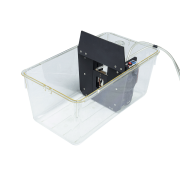


Plantar test for thermal stimulation (Hargreaves Apparatus)
Features&benefits
- Automatic detection of paw withdrawal via fiber-optic detection
- No visual score needed! No mistakes, precise measurement
- Function keys on the controller unit to adjust I.R. intensity in the interval 01-99
- CUB Software included for direct connection to the PC, when required
- USB Flash drive included for easy data portability
- Modular Animal Enclosure from 3 to 12 spaces, conveniently designed to restrain mice or rats
- Optional I.R. Flux Radiometer for calibration to guarantee the same emission in different machines, and after years of use
Focus the infrared source below the Plantar surface and with the press of a button … latency to paw withdrawal and infrared intensity are recorded automatically (i.e.no manual scoring, as in other models available on the market!).
The Plantar Test represents a remarkable advance in methodology, as it combines the best features of all other methods of measuring pain sensitivity. Unique to the Plantar Test, the animal is unrestrained during experiments. Unlike other models available on the market, time latency is recorded automatically by a fiber optic sensor, without having to rely on the experimenter observation of the animal behaviour, thus avoiding unwanted experimental bias.
The Plantar Test basically consists of a movable I.R. (infrared) generator placed below a glass pane upon which the operator deposits the rat, see picture. A Perspex enclosure defines the space within which the animal is unrestrained. It is divided in three compartments, which help the operator to carry out a rapid “screening” work: up to 12 animals can be tested with no appreciable delay in between.
Proprietary to our model is a specific filter, cutting off the visible part of the light spectrum, which would disturb the animal on test and provide an unwanted clue. A feedback circuit detects false starts. Data appear on the front panel and may be exported to a USB pen-drive, or to the PC via USB; both USB pen-drive and software are included in the standard package.
Data can be printed out on the optional panel-mount printer, or external MiniPrinter.
Applications
Determination of acute nociceptive thermal threshold in laboratory animals has primarily relied upon the tail flick and hot plate methods.
Although both methods are used frequently in pharmacological studies, they are not without limitation. In addition, neither method has been extended to investigating behavioural responses to hyperalgesia.
The Plantar Test represents a remarkable advance in methodology, as it combines the best features of all other methods of measuring pain sensitivity. Unique to the Plantar Test, the animal is unrestrained and unhandled during experiments.
Operation
- Power Requirement: Universal mains 85-264 VAC, 50-60Hz
- Commands: via soft-buttons
- Read-out: on multifunction graphic display
- Print-out: via optional thermal MiniPrinter or panel-mount printer
- Starting: via keys on the I.R. Vessel and on the Controller
- R. Intensity: adjustable in the interval 01-99 (in one digit steps)
- Latency Time: displayed on the graphic display, in 0.1s steps
- Connection to PC: via USB cable
- Data Portability via USB flash drive provided
- Calibration: via appropriate I.R. Radiometer (optional)
- Operating temperaturę: 10° to 40° C
- Sound level: negligible
Physical
Dimensions: 86 x 40 x 35 cm (assembled)
Weight 13.00 kg
Packing 98x49x47 cm
Shipping weight: 27.50 kg approx.
Warranty: 17400 is covered by 24-month warranty
- 37370-001 Plantar Test Controller
- 37370-002 Emitter/Detector Vessel
- 37000-003 Large Platform
- 37370-327 Supporting column (4)
- 37000-006 Modular Animal Enclosure (No. 3 Modules M-S 085)
- 37370-005 Framed Glass Pane
- E-AU 041 Memory Flash Drive, including 37370-302 Instruction Manual and 52050-10 CUB DAQ Software
- E-WP 008 Mains Cable
- 52010-323 USB cable
- K.M. Hargreaves, R. Dubner, F. Brown, C. Flores and J. Joris: ”A New and Sensitive Method for Measuring Thermal Nociception in Cutaneous Hy-peralgesia” Pain 32: 77-88, 1988
- D.C. Yeomans & H.K. Proudfit: ”Characterization of the Foot Withdrawal Response to Noxious Radiant Heat in the Rat” Pain 59: 85-97, 1994





